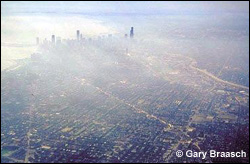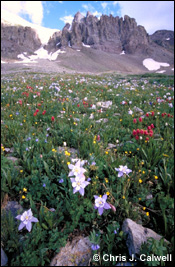12 August 2007
CLIMATE PATTERN CHANGES
- Warmer temperatures
Average temperatures will rise, as will the frequency of heat waves.
- Drought and wildfire
Warmer temperatures could also increase the probability of drought. Greater evaporation, particularly during summer and fall, could exacerbate drought conditions and increase the risk of wildfires.
- More intense rainstorms
Warmer temperatures increase the energy of the climatic system and lead to more intense rainfall at some times and in some areas.

More frequent and more intensive heat waves could result in more heat-related deaths. Photo: Gary Braasch, Chicago, July 1995. See the World View of Global Warming website for more Gary Braasch photos illustrating the consequences of the changing climate.
HEALTH EFFECTS
More frequent and more intensive heat waves could result in more heat-related deaths. These conditions could also aggravate local air quality problems. Global warming is expected to increase the potential geographic range and virulence of tropical diseases as well.
Climate change may also affect people's health both directly and indirectly. For example, heat stress and other heat-related health problems are the direct result of very warm temperatures and high humidity. Untreated, heat stress can be a very serious medical problem. Scientists suspect that, in many places, climate change will increase the number of very hot days that occur during the year. More hot days increases the possibility of heat-related health problems.
Indirectly, ecological disturbances, air pollution, changes in food and water supplies, and coastal flooding are all examples of possible impacts that might affect human health.
How people and nature adapt to climate change will determine how seriously it impacts human health. Some people and places are likely to be affected more than others. Generally, poor people and poor countries are less likely to have the money and resources they need to cope with preventing and treating health problems. Very young children and the elderly will run the highest risk.
WARMING WATER
- Melting glaciers, early ice thaw and sea level rises
Global warming may make the sea level rise. Why? Well, warmer weather makes glaciers melt. A glacier is a large sheet of ice that moves very, very slowly. Some melting glaciers add more water to the ocean. Warmer temperatures also expand water. When water expands in the ocean, it takes up more space and the level of the sea rises.
Sea level may rise between several inches and as much as 3 feet during the next century. This will effect both natural systems and manmade structures along coastlines. Coastal flooding could cause saltwater to flow into areas where salt is harmful, threatening plants and animals in those areas. For example, an increase in the salt content of the Delaware and Chesapeake Bays is thought to have decreased the number of oysters able to live in those waters.
Oceanfront property would be affected by flooding, and beach erosion could leave structures even more vulnerable to storm waves. Whether we move away from the water, or build barricades to face the rising sea, it could cost billions of dollars to adapt to such change. Coastal flooding also may reduce the quality of drinking water in coastal areas.

The satellite photo at far left shows the Larson B ice shelf on 31, January, 2002. Ice appears as solid white. Moving to the right, in photos taken 17 February and 23 February, the ice begins to disintegrate. In the photos at far right, taken 5, March and 7, March, note water (blue) where solid ice had existed, and that a portion of the shelf is drifting away. Photos: National Aeronautics and Space Administration
ECOSYSTEM DISRUPTION
- Ecosystem shifts and species die-off
Climate change may alter the world's habitats and ecosystems, all living things are included in and rely on these places. Many of these places depend on a delicate balance of rainfall, temperature, and soil type. A rapid change in climate could upset this balance and seriously endanger many living things.
Most past climate changes occurred slowly, allowing plants and animals to adapt to the new environment or move somewhere else. However, if future climate changes occur as rapidly as some scientists predict, plants and animals may not be able to react quickly enough to survive. The ocean's ecosystems also could be affected for the same reasons.

Warmer temperatures may cause some ecosystems, including Alpine Meadows in the Rocky Mountains, to disappear.
Unless we act now, our children will inherit a hotter world, dirtier air and water, more severe floods and droughts, and more wildfire.
References:
http://www.nrdc.org/globalWarming/fcons.asp.
http://www.nrdc.org/globalWarming/fcons.asp.
Samar Y. Elgamal